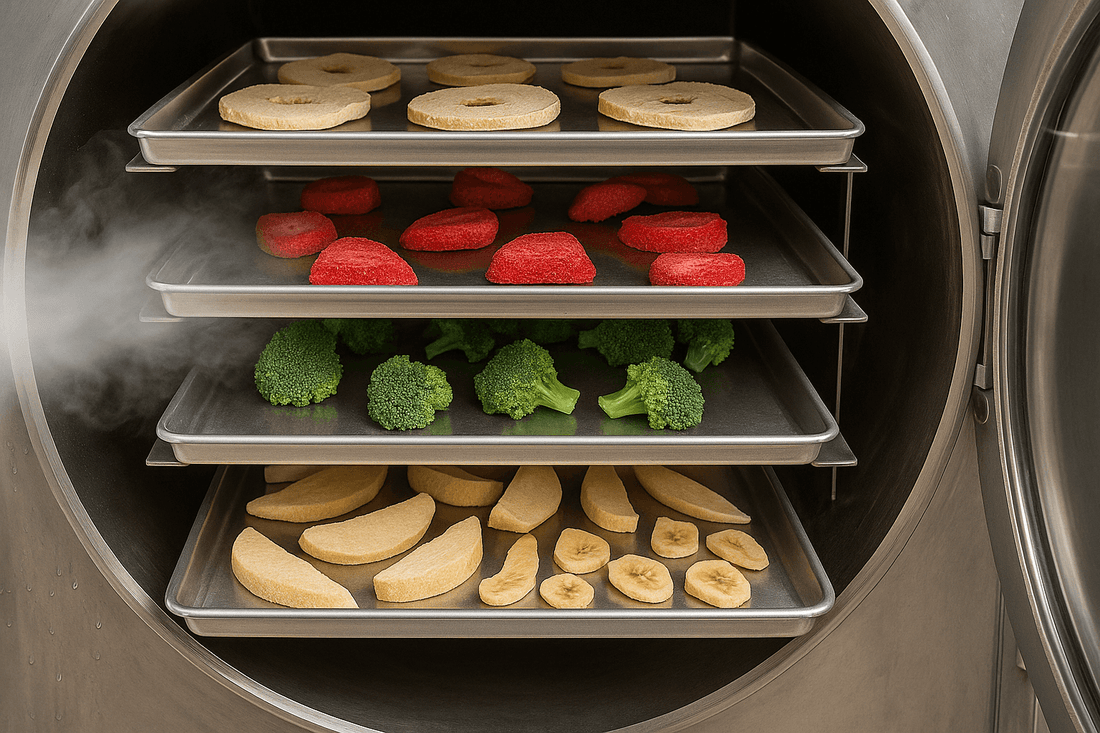
The Science Behind Freeze-Drying: How We Keep the Crunch & the Nutrients
Share
If your kids have ever bitten into a Hapinest snack and smiled at the satisfying crunch, you might wonder—how do we make fruits and veggies so crispy, fun, and still nutritious?
The answer is science. Specifically, freeze-drying—a remarkable process that lets us turn fresh produce into shelf-stable snacks without losing their natural goodness. In this post, we’ll break down how freeze-drying works, why it’s different from other methods, and why your child’s snack-time crunch is also a nutritional win.
🧬 What Is Freeze-Drying?
Freeze-drying (scientific name: lyophilization) is a low-temperature dehydration process that removes water from food while preserving its original structure, nutrients, and flavor.
It sounds high-tech—and it is. But the magic of freeze-drying lies in its simplicity: instead of using heat (like baking or air-drying), we use cold temperatures and pressure to gently pull water from fruits and vegetables without damaging their delicate vitamins and textures.
❄️ How Freeze-Drying Works (Step-by-Step)
Let’s take a closer look at how Hapinest uses freeze-drying to transform fresh fruits and veggies into crunchy, fun-shaped snacks:
1. Harvesting Fresh Produce
It starts with carefully selected, ripe produce—like strawberries, carrots, bananas, or peas. We pick fruits and veggies at peak ripeness to lock in maximum flavor and nutrients.
2. Quick Freezing
The produce is rapidly frozen at temperatures well below 0°F. Freezing the food locks in structure, color, and nutritional content before the drying process begins.
3. Vacuum Sublimation
This is where the science gets cool—literally. The frozen food is placed in a vacuum chamber. Instead of melting, the frozen water inside the produce sublimates (goes directly from solid to vapor) due to low pressure. This removes nearly all moisture without heat.
4. Final Drying & Sealing
Once dried, the food is sealed in air-tight packaging to prevent moisture reabsorption. What you’re left with is a crunchy, colorful, and nutrient-dense snack that can last for months—or even years—without preservatives.
🧠 Why This Matters: Nutrient Retention
Here’s the real win for parents: freeze-drying retains up to 95% of the original nutrients found in fresh fruits and veggies.
💡 Compared to Other Methods:
| Method | Nutrient Retention | Uses Heat? | Texture |
|---|---|---|---|
| Freeze-Drying | 90–95% | ❌ No | Light, crispy |
| Dehydrating | 60–75% | ✅ Yes | Chewy, tough |
| Baking/Roasting | 50–60% | ✅ Yes | Crunchy, but altered flavor |
| Frying | <50% | ✅ Yes | Crispy, but often oily |
Vitamin C, B vitamins, and antioxidants—which are sensitive to heat—survive the freeze-drying process much better than with traditional drying or cooking. That means your kids are actually getting real nutrition, not just empty crunch.
🔬 The Crunch Factor: Why Kids Love It
Kids don’t just eat with their mouths—they eat with their senses. And that signature freeze-dried crunch? It checks all the boxes:
- Sound – A satisfying snap that signals freshness
- Texture – Light and crisp (not chewy or sticky like many dried snacks)
- Visual appeal – Bright colors and fun shapes stay intact
- Taste – The natural flavor of fruit or veggies, with no added sugar needed
At Hapinest, we go a step further by shaping our snacks into flowers, animals, dinosaurs and more—making healthy choices feel like a treat, not a chore.
🧪 Is Freeze-Drying Safe?
Absolutely. Freeze-drying is widely used in the food industry, space programs (yes, astronauts eat freeze-dried meals!), and even pharmaceuticals. It requires no chemical preservatives, no frying, and no high heat—making it one of the cleanest ways to preserve food.
Hapinest snacks are:
- 🧼 Free from added sugar, dyes, or preservatives
- 🌱 Made from real, whole fruits and vegetables
- ✅ Non-GMO and allergy-conscious
- 🥇 Tested for quality and safety at every stage
🌎 Bonus Benefit: Less Waste, More Sustainability
Freeze-drying doesn’t just help kids eat more veggies—it’s good for the planet, too.
✅ Why Freeze-Dried Is Greener:
- Reduces food waste by extending shelf life
- Requires less refrigeration during storage and transport
- Lightweight = lower carbon footprint for shipping
- Zero water needed for snacking on the go
Plus, because our snacks are shelf-stable, parents can stock up without worrying about spoilage—making lunch-packing and road trips easier (and greener).
🎯 Why It Works for Picky Eaters
If your child turns up their nose at broccoli or strawberries on a plate, they might happily crunch on them in freeze-dried form. Here’s why:
- Fun shapes = playful, low-pressure eating
- Familiar crunch = chip-like satisfaction
- No weird textures = no soggy or slimy surprises
- Sweet flavor without added sugar
We’ve seen it time and again—kids who “don’t like veggies” suddenly love our freeze-dried versions. It’s the science of transformation… and a little bit of snack-time magic.
👩🏫 Key Takeaways: The Science Is on Your Side
Here’s what you can confidently tell your fellow parents at the park:
- Freeze-drying uses cold and pressure—not heat—to preserve food
- It keeps more nutrients than any other drying method
- It results in a crispy, kid-approved texture
- It allows us to avoid preservatives, added sugar, or artificial colors
- It’s fun, clean, and shelf-stable
So when you hand your child a pouch of Hapinest snacks, you're not just giving them something crunchy and fun—you're giving them the best of food science, nutrition, and creativity in one bite.
🍓 Try the Freeze-Dried Difference
From crunchy carrots to smiling strawberries, Hapinest freeze-dried snacks turn snack time into smile time—with zero guilt and all the goodness.
✅ Packed with vitamins
✅ Designed for picky eaters
✅ No added sugar or preservatives
Explore our snack lineup and make snack time smart, simple, and seriously fun.



